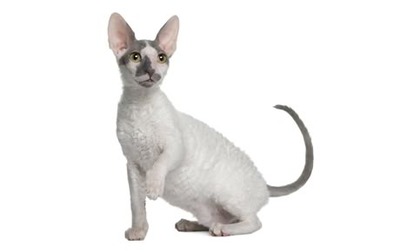Type the name of the breed you're looking for below
[wpdreams_ajaxsearchlite] Don't see the breed your're looking for? Click here and let us know!
Breed Characteristics
1 paw - breed exhibits the least amount of this characteristic
5 paws - breed exhibits most amount of this characteristic
Cornish Rex
| Origin And History | The first known Cornish was discovered on July 21, 1950, on a farm in Bodmin Moor, Cornwall, England, where Serena, a tortoiseshell and white domestic, gave birth to five kittens. The litter contained one curly-coated orange and white male kitten, which Nina Ennismore, Serena's mom, named Kallibunker. Kallibunker was noticeably different from his litter mates. His hair was short and curly and, instead of possessing the cobby body like that of his litter mates and mother, Kallibunker?s body was long and lithe. He possessed large ears, a slender tail, and a foreign wedge-shaped head. Ennismore, interested in this mini-mutant mouser, got in touch with a British geneticist, who agreed that the fur of Kallibunker was similar to the Rex rabbit's fur. On the advice of the geneticist, Ennismore backcrossed Kallibunker to his mother. This mating produced a litter containing one straight-coated kitten and two curly-coated kittens. A second breeding was arranged for Kallibunker and Mom, and again curly-coated kittens were produced. The name Cornish Rex was decided upon for the new breed because of the breed's resemblance to the curly-coated Astrex rabbit. Two Cornish Rexes arrived in America in 1957, courtesy of fancier Fran Blancheri. One died shortly after arrival, but the other, LaMorna Cove, who was pregnant by Poldhu (one of the kittens sired by Kallibunker), survived and produced a Rex litter. LaMorna and family became the foundation cats for the Cornish Rex in America. Since the gene pool was small, breeders outcrossed to other breeds to maintain genetic diversity. Siamese, Havana Browns, American Shorthairs, and domestic shorthairs were among the breeds used. This not only provided genetic diversity, but a wide selection of colors and patterns from which to choose. Outcrossing has since been disallowed because there's now enough diversity to keep the breed healthy. The CFA accepted the Cornish for Championship in 1964; all the North American registries now accept the Cornish. |
| Personality | Cornish Rexes are good for folks who like having their lives run by active, inquisitive, gazelle-like felines that love a good joke, as long as it's not on them. Everything is a game to the Cornish Rex, and they can be hard to ignore when they're in a sociable mood, which is most of the time. Rexes are determinedly outgoing with their favorite humans. With their warm suede feel, they make the perfect winter lap warmer, too. They are intelligent, alert, and usually easy to handle. Extremely affectionate, Rexes are particularly so around dinnertime, so devoted, in fact, that you can't keep them out of your plate without a squirt bottle. Dinner will never be the same again with a purring Cornish stealing your food as soon as your back is turned, or even while you're looking. Some Rexes enjoy retrieving and will bring back objects for you to toss again and again. They are adept climbers, leapers, and sprinters, and have marvelously agile paws. No shelf or cupboard is safe from a persistent Cornish. |
Physical Attributes
| Appearance | The Cornish Rex shares similarities, and differences, with the Devon Rex. The Rex coats of both the Cornish and the Devon are governed by recessive genes. Both create similar changes in the coat. The mutation seems to affect the body type as well, since Rex kittens have a different conformation than their straight-coated litter mates. The Cornish Rex completely lacks guard hairs. The soft awn hairs make up the Cornish coat and form a tight, uniform wave that lies close to the body. The awn wave extends from the top of the head, down across the back, sides, and hips, and continues to the tip of the long, tapering tail. This breed is remarkable for its distinct egg-shaped head with high cheekbones, hollow cheeks, a strongly bridged Roman nose, and large ears set high on the head. The body has been compared to that of a Whippet, with its arched back, barrel chest, small waist, and very fine, long legs. In spite of their dainty appearance, these small to medium sized cats are extremely hard-bodied and muscular, using their well developed hips and long legs for fast starts and stops, quick turns, and high jumps. |
| Health | Their body temperature of 39 °C (102 °F) is slightly higher than that of most cats, with Cornish Rexes tending to hang around warm places such as computer monitors, light bulbs, laps and shoulders. Some Cornish Rexes also have a mild cheesy smell peculiar to the breed; this odor comes from scent glands in the paws. Despite some belief to the contrary, the Cornish Rex's short hair does not make it non- or hypo-allergenic. Allergic reactions from cats are not the result of hair length, the true culprit is a glyco-protein known as Fel d 1, produced in the sebaceous glands of the skin, saliva, and urine. Most people who have cat allergies are reacting to this protein in cat saliva and cat dander: when the cat cleans its fur, the saliva dries and is transformed into dust which people breathe in. Since Cornish Rex cats groom as much as or even more than ordinary cats, a Cornish Rex cat can still produce a reaction in people who are allergic to cats. However, it is widely reported to cause lesser to little allergic reaction. It is recommended a potential owner visit a cattery to check their own tolerance. Note that, for more serious allergies, there are several breeds theorized to lack or produce less of the offending protein. |



